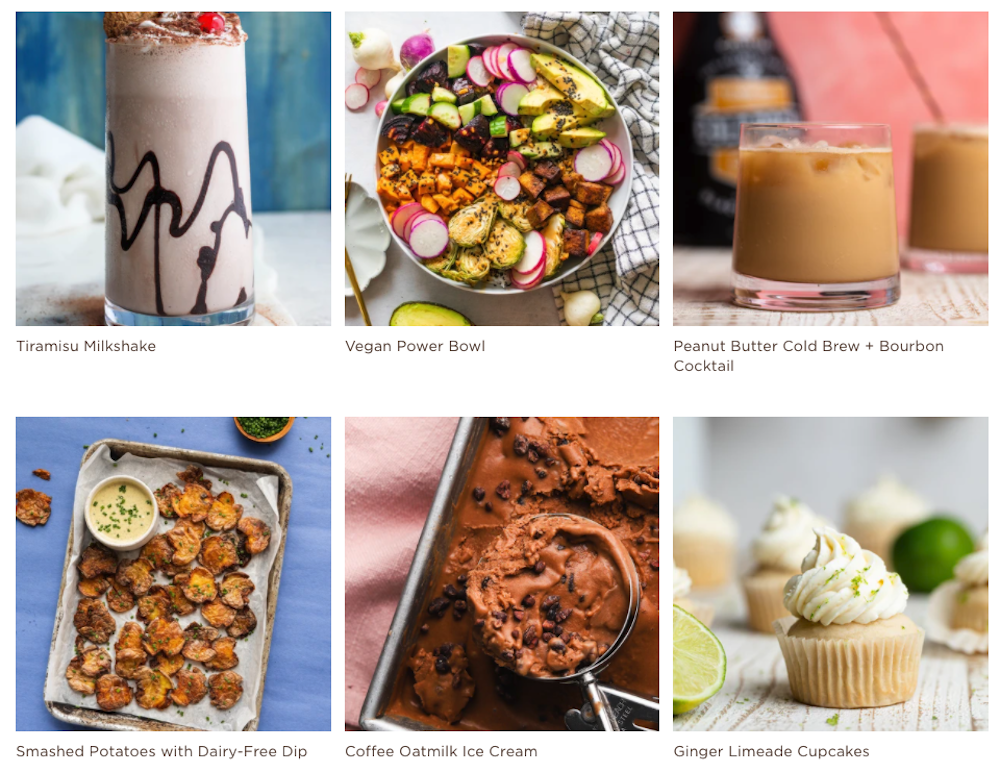The best D2C websites leverage a wide range of engaging shopping experiences to build connections with shoppers.
From customized and personalized products to strong brand storytelling and high-quality product content, here are some of the best examples of D2C websites and tips on how your brand could apply these examples to your D2C strategy.
1. Califia Farms’ Recipes Inspire Home Chefs
Milk alternatives have exploded in popularity in recent years, and the Califia Farms D2C website offers a wide range of recipes created with its range of plant-based dairy-free products.
These recipes promote a healthy, dairy-free lifestyle — a big part of Califia Farms’ brand mission — and help shoppers engage directly with the brand.
For food or beverage brands, additional content like recipes could be a helpful and entertaining way to engage shoppers. Not only does it help them widen their use of your products, but it also draws more attention to your D2C website.
2. Vita Coco Offers Exclusive Influencer Products
Vita Coco stands out from other plant-based drinks with its unique hydrating properties, tropical taste, and fun packaging.
The brand has also found a unique way to promote its brand with an exclusive clothing collaboration with social media influencer Bretman Rock, with all proceeds going towards the “Vita Coco Project to support coconut farming communities in the Philippines.”

Your brand has an opportunity to offer exclusive products on your D2C website to drive engagement. Partnering with social media influencers also helps to solidify your brand identity and drive engagement.
3. Vera Bradley Offers Personalization
Vera Bradley differentiates itself on its website by offering customized products. Exclusively offered on its website, shoppers can choose the product type, strap colors, print, and more — and you can even monogram their initials on the product.
This offer isn’t available in stores, making the site an even more desirable shopping experience.

Your brand could drive engagement with customizable and personalizable products, driving demand with exclusivity.
4. Libbey Leverages Visual Storytelling
Glassware brand Libbey uses compelling editorial imagery on its D2C site — from tables with elaborate meals to happy people clinking their glasses together in celebration.
The Libbey website offers more than just luxury tableware and foodservice experiences; it also helps shoppers better visualize how the products would look and function within their homes.
Libbey prioritizes using this “descriptive” imagery on its D2C website. This style of product content could also be leveraged successfully by other home goods brands to build up the aesthetic experience of their products and brand.
5. POLYWOOD Promotes Its Mission of Sustainability
Furniture brand POLYWOOD differentiates itself by using its D2C website to highlight its sustainability mission. As a company that prides itself on using environmentally conscious materials and processes, its website leverages brand content like graphics, video, and other product content to illustrate its commitment to these practices.
“Let’s do something meaningful for future generations,” says Doug Rassi, founder and CEO of POLYWOOD, on the website.
Video Source: POLYWOOD YouTube
Brand storytelling effectively highlights causes your brand supports or manufacturing processes to highlight product quality. When shoppers connect with your mission, it could help support lasting relationships with your brand.
Inspiration Drives Innovation
D2C websites work best when they offer a way for your consumers to engage with your brand. Whether through personalized or exclusive products or helpful recipes that leverage your products, consumers love excellent shopping experiences — and these experiences build lasting relationships for your brand.
Download the five-part “The Complete Product Page Toolkit” to learn how to optimize your website and drive more consumers to your product page.






